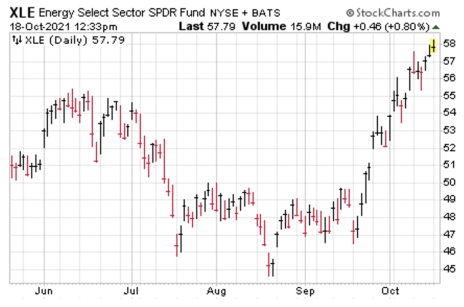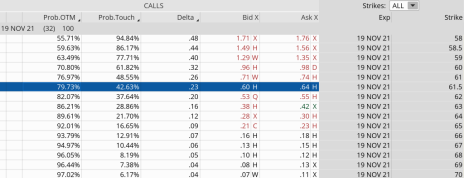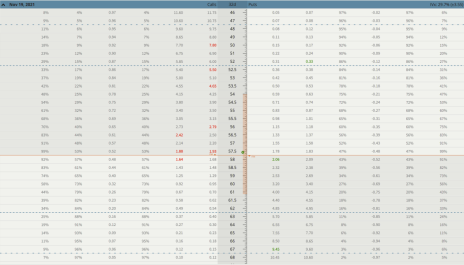Over the weekend I received an email asking the following question:
“Hi Andy,
Can you make a post about this with an example using any stock/ETF or point me to one if it already exists? You are the first person I’ve come across that is looking at RSI readings from different time scales so I’m very interested in educating myself further on how one can apply this. Thanks. Farhan A.”
Farhan’s question is one that I have received quite often lately, so I want to address it today.
[text_ad use_post='261460']
Looking at a Potential Trade
At the end of each week I post my High Probability Mean-Reversion Indicator (HPMR) in addition to the current implied volatility (IV) and IV rank. Knowing all of the aforementioned information going into each week helps me to prepare for any potential trades, opening or closing, for the upcoming trading week. For a portion of my strategies, I find it helpful to know these levels.
And as I state each week, I like to use three different RSI readings: the 2-day, 5-day and the standard 14-day. Each timeframe gives me a different idea as to how a security has performed over the short, intermediate and long term.
But I also understand the limitations of using RSI, especially in the case when RSI moves into an overbought state, which is why I have created my own proprietary reading to combat some of the weaknesses offered by RSI. My preference is to wait until I see an extreme reading in one of the underlyings on my watchlist and then peruse a variety of different credit spreads like a bear call spread, bull spread or even an iron condor to use depending on the current extreme reading.
Now as we all should realize, there is no holy grail to indicators. It doesn’t exist. But knowing when an ETF hits an overbought or oversold extreme allows me to increase my odds on a trade. Especially when you consider I’m already using an options strategy with a high probability of success. Moreover, by using a spread I’m inherently creating a margin of error just in case the ETF I’m trading continues to trend deeper into an extreme.
Below is the reading from last week.
If we quickly scour the overbought-oversold column we can see that there are a few ETFs moving into an extreme state.
As we can see, SPDR Energy Select (XLE) and Vaneck Gold Miners (GLD) have readings above 80. They haven’t reached an extreme overbought state but are certainly moving in that direction.
Let’s take a closer look at XLE for our example.
XLE is currently trading for 57.79.
Knowing that it is in an overbought state and pushing deeper into that state, I want to look to fade the move, due to mean-reversion, by using a bear call options strategy.
A bear call spread is otherwise known as a short call vertical spread. As the name of the options strategy implies, a bear call spread is bearish leaning. However, the strategy doesn’t require the security to move lower to make money. Unlike the binary nature of stock strategies, a stock can either go up or down with a bear call spread. So, you not only have the ability to make a return when a security moves lower, you can also make money if the stock stays flat or even if the stock pushes slightly higher.
The Trade
Let’s start by taking a look at the options chain for XLE with 32 days until expiration. Once we choose our expiration cycle (it will differ in duration depending on outlook and strategy), we begin the process of looking for our short call strike within the November 19, 2021 expiration cycle that has around an 80% probability of success.
If you don’t have access to probabilities of success on your trading platform look towards the delta.
Without going into too much detail, look for a call strike that has a delta around 0.20, if not lower.
For our example, let’s focus on the 61.5 call strike. By using the 61.5 strike as the short call portion of our bear call spread, we are defining our probability of success on the trade. In this case, the probability of success is 79.73%. The probability of XLE touching the 61.5 call strike sometime between when we place the trade and expiration is 42.63%. I like those probabilities.
Next, I want to know what the expected move or expected range is for XLE during the November 19, 2021 expiration cycle.
The range is currently from 54 to just over 61.
Since we are focused on using a bearish spread example, we only care about the upside risk at the moment.
By knowing that the market anticipates XLE going as high as 61 by November expiration in 32 days, it allows us to choose a short call strike preferably outside that number. Again, this will define our probability of success on the trade.
It also helps to define my overall premium or return on the trade. Basically, as long as XLE stays below the 61.5 call strike at the November 19, 2021 expiration in 32 days we will make a max profit on the trade.
But, as I stated before, my preference is to take off profits early and, in most cases, reestablish a position if warranted.
Also, time decay works in our favor on the trade, so as we get closer and closer to expiration our premium will erode at an accelerated rate. As a result, we should have the opportunity to take the bear call spread off for a nice profit prior to expiration—unless of course XLE spikes to the upside over the next 32 days. But still, that doesn’t hide the fact that with this trade, we can be completely wrong in our directional assumption and still make a max profit.
Once I’ve chosen my short call strike, in this case the 61.5 call, I then proceed to look at the other half of a 3-strike-wide, 4-strike-wide and 5-strike-wide spread to buy. Establishing the spread width of our bear call defines our risk/capital on the trade. The smaller the width of our bear call spread the less capital required, and vice versa for a wider bear call spread.
Let’s go with the 65 strike for our example. This gives us a 3.5-strike-wide spread on what is now the 61.5/65 bear call spread we will look to execute.
Now that we have chosen our spread, we can execute the trade.
Simultaneously:
Sell to open XLE November 19, 2021 61.5 call strike.
Buy to open XLE November 19, 2021 65 call strike for a total net credit of roughly $0.42 or $42 per bear call spread.
- Probability of Success: 79.73%
- Total net credit: $0.42, or $42 per bear call spread
- Total risk per spread: $3.08 or $308 per bear call spread
- Max Potential Return: 13.6%
As long as XLE stays below our 61.5 strike at expiration in 32 days, I have the potential to make a max profit of 13.6% on the trade. My preference is to look for returns a bit higher, mostly ranging from 15% to upwards of 40% per trade.
We could drop our probability of success slightly to get us there. For example, we could go with the 60/65 bear call spread. The spread would offer just over a 70% probability of success and allow us to bring in roughly $0.75, for a return of 17.6% over 32 days.
These are the types of decisions that you will have to make as a trader. But, if you have a risk management plan in place that is consistent from trade to trade, your decisions will be far easier.
Getting back to our trade, in most cases, I will make slightly less than the original credit, as the prudent move, due to an abundance of research, is to buy back the bear call spread prior to expiration. Again, I look to buy back a spread when I can lock in 50% to 75% of the original credit. Since we sold the spread for $0.42, I would look to buy it back when the price of my spread hits roughly $0.21 to $0.10.
Of course, there are a variety of factors to consider with each trade. And we allow the probabilities and time to expiration to lead the way for our decisions. But, taking off risk, or at least half the risk, by locking in profits is never a bad decision and by doing so we can take advantage of other opportunities the market has to offer.
Risk Management
Since we know how much we stand to make and lose prior to order entry we can precisely define our position size on every trade we place. Position size is the most important factor when managing risk, so keeping each trade at a reasonable level (I use 1% to 5% per trade) allows not only the Law of Large Numbers to work in your favor … it also allows you to sleep well at night.
I also tend to set a stop-loss that sits 2 to 3 times my original credit. Since I’m selling the 61.5/65 bear call spread for $0.42, if my bear call spread reaches approximately $0.84 to $1.26, I will exit the trade. Typically, the higher the probability the trade, the more prone I am to go closer to 2x the original credit.
As always, if you have any questions, please do not hesitate to email me or post a question in the comments section below.





